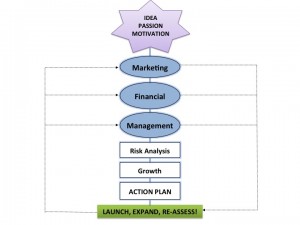The post Getting into Business appeared first on Paul Terry & Associates.
]]>
Passion is essential
First, passion and conviction are essential. You need to know who you are and what you want to do. Then there is the choice of business model and knowing your product or service inside and out. You want to be ready to eat, drink and breathe business ownership… and wake up and do it again the very next day.
Know your market
Even if you have the best business idea and you are confident in your ability to make a product or provide a service and set up a successful business model, the great arbiter of success is the marketplace. Your business concept must be viable, not just to you, but to the people who will be your target market. How do you know your business expectations are not fiction? To get the answer, you must talk to people, survey potential customers or clients, and test your assumptions.
Test your concept
Once you have an idea of the marketplace, you want to test the concept. You can pop up in someone else’s space or test your product or service at a street fair or makers fair. You can get friends to hold events and sell your product in their living rooms. You can convince a friend who has a retail shop to let you set up a trunk show. If all goes well, the experience will make you feel more secure that your business idea is a good one and that you want to own and run a business.
Can you now say YES to these 5 key questions?
- Do I really enjoy being in business?
- Can I attract the customer or client who will appreciate my business and will pay for it?
- Am I good with customers and can I provide excellent service?
- Does my business model make money or will it at least break even “soon”?
- Can I envision myself persevering for the next 12 to 18 months to really establish my business?
Time for planning
Some degree of prior business planning is essential. To help guide you, you can take a class, read a book, or ask an experienced business owner for support. However you do it, the purpose of a plan is to define your business offerings, specify your market, outline the essential management skills needed, and create realistic financial projections with a well-timed series of action steps. Your final plan will be a useful document for potential investors, funders or business partners. But the primary purpose for writing a plan is for the process itself. It forces you to be objective and critical, identifying weaknesses, challenges and opportunities and setting benchmarks to track progress. Ultimately, it will give you confidence to get into and continue with the business.
Take the plunge
So you have made some initial sales, carved out time on weekends to work on the business and you are still excited about doing it. Actually, it is all you can think about. How do you take the plunge from part-time to all-in?
There are many different ways to do it.
- Wait to launch until you have raised enough start -up capital – either through personal savings, bank loans or crowd fundraising.
- Convince your friends and family to lend you money (perhaps with no interest) and agree that you do not have to pay them back for at least three years.
- Approach your employer and negotiate to work only four days a week and use that extra day to work on your business.
- Move from full-time employment to a contractual arrangement so that you can set your own hours and take time off when needed for the business.
- Find an active or silent business partner with capital to invest in the new business and cover business expenses for the first year.
- Marry well and/or use your future inheritance to support your entrepreneurship habit!
- Quit your job and go all in right away, using credit cards to get you through the cash flow negative start-up period.
The path to small business ownership is unique for each entrepreneur. It depends on your tolerance for risk, your access to capital and cash flow, your skills and experience running/managing a similar enterprise, and your support systems.
Time, money and the prospect of failure are common hurdles for almost every small business owner starting out:
- How do I find enough time to devote to my business?
- Do I have enough funds to support myself while the business is developing/evolving in the first 6, 12 or 18 months?
- Can I respond well to short-term failures as I navigate my way to long-term success?
You may struggle to find the right strategy to get your business off the ground but if you have passion for your business idea, some success from product or service testing, solid financial projections, and a strong support network… YOU CAN DO THIS!
Are entrepreneurs crazy? Sometimes yes. But that’s just what may be needed to jump in and swim! Some start in the shallow end of the pool and tip-toe down the stairs. Others lower themselves down the ladder until they are fully immersed but continue to hold onto the edge. And then there are the ones who leap off the diving board straight into the deep end. No matter your approach, just make sure you can see the edge and make your way back to solid ground as needed. But if you really want to swim in the world of small business ownership, you first just have to get into the water!
The post Getting into Business appeared first on Paul Terry & Associates.
]]>The post Planning for Business Success appeared first on Paul Terry & Associates.
]]>
You can reduce those risks if you set aside time to plan in advance. This means defining your business offerings, doing specific market research, recognizing the essential management skills you need, and projecting realistic financial expectations… in short, you can reduce risks when you write and use a business plan.
Small business owners often say they don’t have time to write a business plan. There is too much to do and they want to get on with running the business. (Or, they may be intimidated by the planning process or simply be procrastinating.)
It’s true that some small businesses start without planning and do very well. However, once a business is launched and things get complicated, it can be confusing to figure out next steps. A good business plan helps sort out your options and can help you focus.
Business experts disagree about the importance of writing a business plan. Though some research has found that writing a plan greatly increases the chances that a person actually goes into business, there are business school professors out there, like Steve Blank, who say that real entrepreneurs don’t write business plans.
Although it may not sound like it, I actually agree with Blank’s approach. In his Lean LaunchPad classes, he’s pushing students to constantly talk to people and test their theories as they plan. A hands-on, real world approach is central to how I teach entrepreneurship, too. You cannot write a business plan in a vacuum and expect it to serve you well. You must get out there, connect with people, and constantly test your assumptions.
Writing, implementing and maintaining a business plan is hard work. Planning means learning to take the pulse of your business — over and over again. You have to be open to new ideas and be willing to learn from your mistakes. There is a reward for all that hard work, though. You end up with an operational management tool, a marketing plan, financial projections, and a means of communicating your business to others.
The primary purpose for writing a plan, though, is for the process itself. It forces you to be objective and critical, identifying weaknesses, challenges and opportunities and setting benchmarks to track progress. Doing research, talking to people, and analyzing your operation will give you confidence to continue with the business.
It’s really important that the plan reflects your unique owner perspective. The plan is a foundation from which each owner’s business judgment, personal feelings and intuition are measured. You should write it in such a way that you can use it, in a format that is easy to update. To be truly useful, a business plan should be a dynamic document — current, accessible and appropriate for the business. Don’t spend a lot of time making a pretty document unless a formal plan is needed to present to a bank or other investor. It doesn’t have to be perfect looking; the key is that it is useful for you and your business.
A business plan doesn’t guarantee success but it can help prevent serious mistakes. It is a great way to stay attentive to the important details of your business, to industry trends and competitors, and to new directions and business growth. A good business plan will help you maintain profitability, acknowledge and minimize potential risks, and develop confidence for future opportunities.
So how do you find the time to write a business plan? As Tim Berry says, “You don’t. You are always planning. Your plan is never done but your planning process is your key to good management.”
So, write that plan (or revisit your old one). It will be well worth your effort!
The post Planning for Business Success appeared first on Paul Terry & Associates.
]]>The post Home-based Foodies in the Game appeared first on Paul Terry & Associates.
]]>
In January, 2013 the California Homemade Food Act was signed into law, making it legal for people to sell “low-risk foods” produced in their home kitchens. A food entrepreneur who wants to qualify as a Cottage Food Operation must meet a few criteria:
- Produce foods on the approved list,
- Have gross sales this year of $35,000 or less (by 2015 this will go up to $50,000),
- Complete a food processor training course, and
- Have product labels that meet state and federal requirements.
There are more details of course. Note the two categories of cottage food operation:
- Class A operations can only sell directly to the consumer (which can include at community events, farmers’ markets and through CSA subscriptions) and can register with a self-certification compliance checklist.
- Class B operations must be inspected to receive their permit but can then sell to restaurants, retail food stores and food trucks.
Before this legislation became law, you needed to use a commercial kitchen or food processing facility (such as Eclectic Cookery) to legally sell your food product (or join a kitchen incubator, like La Cocina). For many entrepreneurs who are just starting out, testing their food business ideas by renting a commercial facility is cost prohibitive. Now there is a way to start small at home legally.
The success of the now-closed Underground Market in San Francisco is a clear sign of how many people will be able to benefit from this new law and also how many people want artisanal food. With a pick-up in the economy, there should be more customers for a good product… if it is sold effectively and meets the considerations of the target market. It is a great time for micro businesses and home-based entrepreneurs to really test their products, their ability to do the work and their commitment to be small business owners. There’s a lot of new energy out there to support small food businesses and new policies like this Homemade Food Act to stimulate the growth of the industry.
To learn more about the California Homemade Food Act and how to obtain a cottage food operation permit, go to the San Francisco Department of Public Health and the California Department of Public Health websites.
The post Home-based Foodies in the Game appeared first on Paul Terry & Associates.
]]>The post Testing the Waters appeared first on Paul Terry & Associates.
]]>
Shoe leather approach
Market research can be as simple as asking casual questions, comparing prices, walking around your neighborhood or attending a trade show. I call this “shoe leather research” even if you don’t do it by walking around. You learn by keeping your eyes open, your ears to the ground, and paying attention to what you notice.
Situational Observations
Casual and informal research can also be called situational research. Basically, it involves getting a feel for the industry, the general marketplace, and/or the specific targeted market that you think is right. The process can include informal conversations with potential customers (“I’m thinking of opening an online pet helpline. Would you use something like that?”), direct competitors (“I wonder if you could help me as I’m thinking about opening a shop like yours 50 miles away.”), and potential suppliers (“Can you tell me how much inventory you usually sell to stores that carry your line?”) Sometimes this informal style of research generates enough information to build your confidence and help you get a new business started. Other times, this approach will help an existing business to identify and carry a new product line.
Formalized Primary Research
Shoe leather and situational research can be very helpful but more formalized research may also be needed when trying to determine if your business approach is the right fit. This can include careful observation (watching, counting, recording), interviewing someone relevant to your business area (by phone, in person or online with carefully chosen questions), or preparing a survey to administer to your potential customer base (by mail, in person or online using free software like Survey Monkey).
Secondary Research
It can also be very helpful to do secondary research—getting information from trade journals, census reports and other industry references. There are online services based on Google key words or specific industry data. This form of research is easier in a way (you just go online and ask some questions) but it isn’t always relevant and may be too general for your market. A combination of primary research (done by you to acquire original data) and secondary research are BOTH valid and need to be part of your business planning.
Making the Time
The most important factor when selecting a market research approach is to determine if you have the time to do it and if you will actually compile and use the data. Your research should help you minimize the risks related to the venture you want to undertake, so make the effort to talk to people, gather information from the industry, watch competitors and record your impressions. Testing the waters (even at the shallow end) will make your plunge into business much more successful!
photo credit: http://walkingfit.ucr.edu/faq.html
The post Testing the Waters appeared first on Paul Terry & Associates.
]]>